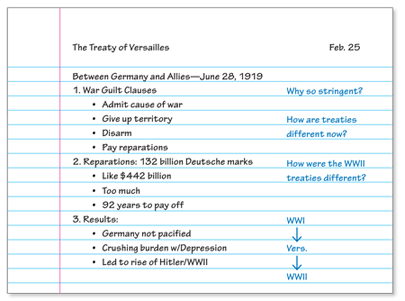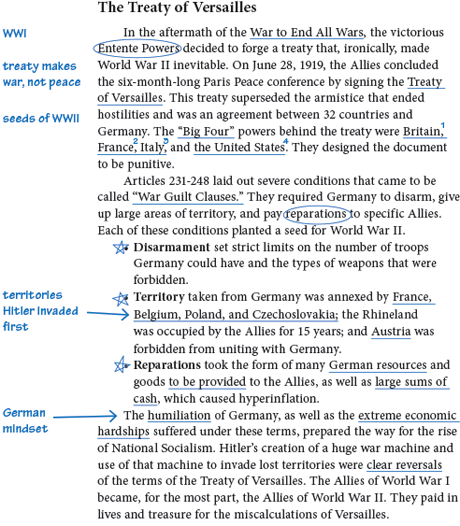142
Reading Actively
You may think that reading is a passive process, just letting information pour in. But to get the most out of your reading, you must actively engage in it.
Tips for Active Reading
When you read, follow these tips to engage actively with the material.
- Question the communication situation. Whatever you read is a message from a sender. It is presented through a medium, in a context, and to an intended receiver.

- Sender: Who wrote this?
- Message: What is the subject? What might the purpose be?
- Medium: How is this message presented? In what way does the medium enhance or detract from the message?
- Receiver: Who is supposed to read this? Am I part of the intended audience?
- Context: When and where was this written? What was going on then? How does the message fit into today’s context? How does it fit with other writings by this author?
- Make predictions about the reading. Before you read, think about what you expect to find out. This will open your mind to the new information. If your expectations are not fulfilled, consider why.
- Write while you read. Jot down names, details, notes, impressions, even drawings. If you own the material, annotate in the margins. (See pages 144-145.) By writing, you engage your kinesthetic sense—involving movement as you process information.
- Speak while you read. Pronounce difficult words. Read aloud any lines that particularly impress you, or things you want to remember. By speaking, you engage your kinesthetic, linguistic, and aural senses, deepening your understanding. The more senses you use, the more deeply you learn.
- Discuss what you read. Tell someone else something interesting about the material. Ask any questions that you have. By discussing what you read, you engage your social mind and help cement your understanding.
Your Turn Before you read the material on the facing page, question the communication situation. Write answers to the questions under number 1 above. Share your answers with a partner.
143
Using Reading Strategies
Reading with KWL
KWL stands for know, want to know, and learned. The KWL reading strategy prompts you to think about what you already know about a topic and what you want to find out in your reading. Then, after you read, you reflect on what you have learned.
Topic: Terminal Velocity
Know | Want to know | Learned |
Terminal velocity is the fastest that an object can fall. I think it’s about 200 miles an hour for a person jumping out of a plane. Different weights aren’t supposed to fall at different speeds, though. | How can there be different terminal velocities for different objects if they all fall at the same rate? | Terminal velocity is reached when the force of gravity equals the force of drag in the air. If two balls are the same size but weigh different amounts, they fall at the same terminal velocity. |
Your Turn Create a three-column chart like the one above. Your topic is SQ3R. In the first column, write what you already know about SQ3R. In the second column, write what you want to know about it. Then read the text below and reflect on what you learned.
Reading with SQ3R
SQ3R is an active-reading strategy that stands for survey, question, read, recite, and review. It helps you get the most meaning out of what you read.
Survey | Look over the text, noting its headings and other boldfaced words, the author, any illustrations, and so on. |
Question | Ask questions that you hope to find answers to in the text. This step keeps you focused as you read the material. |
Read | Move through the text once quickly to understand the big picture. Then read it again more carefully to catch the details. Take notes and annotate as you go along. |
Recite | Speak the main details aloud as you read, engaging more senses to enhance your understanding. |
Review | After your reading, look at your notes and annotations and discuss the text with others. |
Your Turn Use the SQ3R approach to read the material in one of your next reading assignments in a class of your choice.
144
Taking Reading Notes
Taking reading notes focuses your attention on the key information in a text while engaging your kinesthetic and visual senses. The notes give you a record of the main points and your thoughts during the reading. Follow these tips:
- Write down key words and phrases. Writing complete sentences usually takes too long.
- Put ideas in your own words. Paraphrasing helps you to understand and process information.
- Create shortcuts. Use symbols where possible.
- Use dashes, letters, and numbers to keep your notes organized.
- Reserve a wide column on the left for your main notes. Leave a narrow column on the right for questions, comments, and other additions.
- Consider digital note taking. Many online services offer note-taking software that you can use to organize, store, and retrieve notes. To learn more about note taking options, see pages 370–371.

Your Turn Use the tips above to take notes about a page from one of your textbooks.
- Write notes in the margins.
- Underline important ideas.
- Circle new vocabulary words.
- Draw lines to connect ideas.
- Use numbers to sort ideas.
145
Annotating a Text
If you own a text or have a printout, you can highlight, underline, and make comments on the pages themselves. This helps you to remember the ideas later. Use the tips to the right.
Sample Page
Your Turn Photocopy a page from a textbook, or find a page online. Read and annotate it.



